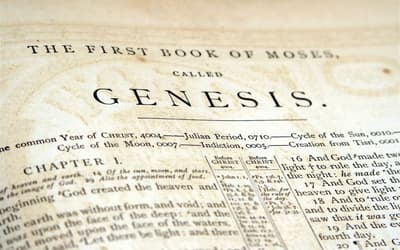The views expressed in this paper are those of the writer(s) and are not necessarily those of the ARJ Editor or Answers in Genesis.
Abstract
Denis Lamoureux seeks to resolve perceived contradictions between science and Scripture by persuading that Scripture is not inerrant, but is infallible in doctrine, and he reasons that the phenomenological language defense (as he terms it) fails to recognize the impact of ancient science upon the text. This is in contrast to the Chicago Statement on Inerrancy, which argues that phenomenological language does not invalidate the inerrancy of the Bible. Lamoureux describes himself as a “literal non-literalist,” but his work exhibits a certain naïveté about lexical semantics (along with a number of other hermeneutical issues undergirding his analysis). The problems with Lamoureux’s analysis can be seen, for example, in his analysis of the mustard seed motif in the gospels, and a wholly inadequate understanding of the idiomatic nature of hyperbole. But, more telling is his failure to recognize the impact that ancient science might have on the terminology used to describe natural phenomenon. This problem is best demonstrated by the impact that ancient theories of biology on the semantic domain of the words translated “heart” in the Bible. This being the case, his arguments against the inerrantist position loses much of its force.
Keywords: exical semantics, Lamoureux, evolutionary creationism, inerrancy, infallibility, concordism, rāqîaʿ, heavens, firmament
Denis Lamoureux’s book Evolutionary Creationism: A Christian Approach to Evolution is one of the controversial works entangled in an ongoing debate between young earth creationists, old earth creationists (commonly called progressive creationists) and Christians who are theistic evolutionists. Lamoureux produced a theistic evolutionary framework and a rejection of inerrancy,1 stating, “The Bible makes statements about the physical world that are false” (Lamoureux 2008, 309). Lamoureux is noteworthy because while he essentially presents a case asserting that Christians should accept theistic evolution; he and others at BioLogos2 use arguments that are more often presented to support the claim that Christianity itself is false, and this is the reason his critique is useful in understanding what may be an important issue raised in criticisms of biblical Christianity. He accepts the truthfulness of these arguments uncritically; thus, he presents an interesting analysis of many perceptions underlying the rejection of inerrancy, and perhaps he pinpoints common misunderstandings of the various “caveats” in the Chicago Statement on Biblical Inerrancy.
Cosmology and Semantics
The Chicago Statement on Biblical Inerrancy reads:
We affirm the propriety of using inerrancy as a theological term with reference to the complete truthfulness of Scripture.
We deny that it is proper to evaluate Scripture according to standards of truth and error that are alien to its usage or purpose. We further deny that inerrancy is negated by Biblical phenomena such as a lack of modern technical precision, irregularities of grammar or spelling, observational descriptions of nature, the reporting of falsehoods, the use of hyperbole and round numbers, the topical arrangement of material, variant selections of material in parallel accounts, or the use of free citations. (Article XIII; emphasis mine)
Lamoureux, however, notes that inerrancy is negated by observational descriptions, by linking them directly to ancient cosmology.
What the biblical writers and other ancient peoples saw with their eyes, they believed to be real, like the literal rising and setting of the sun. In contrast, we view the world from a modern phenomenological perspective [emphasis his]. When we see the sun “rising” and “setting,” we know that it is only an appearance or visual effect caused by the rotation of the earth. Consequently, it is crucial that these two different viewpoints of nature not be confused or conflated. Failure to do so is the problem with the popular phenomenological language argument. (Lamoureux 2008, 109; emphasis mine)
While it is impossible to discuss every point raised in a book of this length without an equally large work,3 much of Lamoureux’s case hinges on terminology found in the Old Testament which Lamoureux compares terminology to “ancient science.” He argues, for example, that rāqîaʿ (Genesis 1:2) must not be translated as “expanse” because of its connection to the verb rāqāʿ “hammered out” (Lamoureux 2008, 123). Thus, besides the chronological snobbery premised in this discussion, and among some other issues, Lamoureux’s rejection of the “phenomenological language argument” is predicated on an element of semantic naïveté.
A Literal Non-Literalist
Idioms old and new
Lamoureux (2008, 324–331) applies a fairly straightforward approach to biblical literature (describing himself as a “non-literal literalist”). A useful example for understanding the contrast between his approach and that of inerrancy is his discussion of the mustard seed in Mark 4:30–32 (Lamoureux 2008, 137). Lamoureux identifies this passage as an error regarding the reality of mustard seeds (Lamoureux 2008, 303), because the mustard seed is described in the text as the “smallest of seeds.” There is no attempt to explore the idiom, or the nuances of the language in the text. He makes no comparisons to rabbinic sources that cite the mustard seed motif, nor the varying usages of the superlative adjective in koine Greek. He borrows, seemingly without criticism, the modernist’s assessment of the passage. As a result, he accepts this as a legitimate scientific error (and since he does not believe in a literal Adam or Fall, this extends to significant historical errors), yet he asserts that this error does not influence the teaching of the “Message of Faith.”4 Nor does he acknowledge the standard discussion of hyperbole in the passage, defining hyperbole as an actual error used as a vehicle for a larger truth.
A believer in inerrancy, instead, would argue that there is no error in the text; only a misunderstanding by modern readers who read a hyperbole as if it were not intended to be hyperbolic.5 This is a simplistic misunderstanding of the idiomatic nature of hyperbole. A man who states he is “hungry enough to eat a horse” is not communicating that his intestines are capable of containing an animal larger than his own body (though a non-native speaker might make the mistake of assuming this to be the point); this is a hyperbole that means he is “very hungry.” This is true of hyperboles in ancient literature as well. This distinction—that the error is, in fact, found within modern readers’ misunderstanding of the genres, idioms, semantics and poetry of ancient texts—underlies many of what are sometimes deemed “caveats” associated with various defenses of biblical inerrancy; the confusion is caused at times by a lack of necessary linguistic sensitivity (and therefore a modern naïveté) in regards to the idioms of ancient languages, since an immersion into the culture is not possible.
Paul’s Kenotic hymn
One of Lamoureux’s early discussions of ancient concepts concerns the Kenotic Hymn in Philippians 2 (Lamoureux 2008, 107–111). He opens a discussion of the belief in a three-tiered universe in Scripture; here it is stated “. . . at the name of Jesus every knee shall bow, of things in heaven, and things on earth, and things under the earth.” His analysis, however, treats the first century cosmopolitan Apostle to the Gentiles as if he were a figure from the Jewish pre-exilic period. Whatever might, or might not, be assumed to be the ancient Hebrews’ understanding of astronomy in the fifteenth century BC, it cannot be forgotten that Paul was writing during the first century, in the Greco-Roman world. A little after Paul’s day, Ptolemy definitively proved that the earth was spherical, and there has been little debate about a flat earth since. Discussions of the spherical shape of the earth were already known and discussed long before Paul: Aristotle (On The Heavens, §297-8) and Plato (Phaedo §108; Timaeus §33) both asserted a spherical earth, largely based in astronomical observations, and the discussions may date back to the times of Pythagoras (Diogenes Laertes Lives of the Eminent Philosophers §2.viii.49). It is certain that Paul was familiar with the classical writers of the Greek world, perhaps in part due to the influence of Gamaliel (Bruce 1980, 237–238). By the time of the missionary journeys he certainly felt sufficiently comfortable with Greek writings to quote them. It is difficult to conceive then, that he lacked familiarity with the opinions supporting belief in a spherical world. Paul’s reference to the third heaven would indicate that he did not conform to the relatively unsophisticated model Lamoureux assigns to him.6
Nor can it simply be assumed that the cosmological belief in a three-tiered universe resides in a source Paul is quoting. If the kenotic hymn is a quotation, Paul chose to make use of it to communicate his larger point. If the language does not necessarily imply a three-tiered universe, what does it imply about Paul’s understanding of astronomy? Perhaps the better question would be the question of whether it has any astronomical implications, at all. The problem is that Lamoureux, and modern critics with him, look for connections between phenomenological observations and ancient science, without considering lexicography; it is forgotten that ancient science may have an impact on the meaning of the terminology used in a passage. Ancient science has a semantic impact on communication, as demonstrated by the “artifacts” that science has left in language.
Artifacts in language
It is common for husbands today (hopefully) to say they love their wives with “all of their hearts.” If, in 2000 years, a Hallmark store were uncovered by persons who had an incomplete knowledge of today’s world (as moderns do of the ancient world), they might infer that the Aristotelian beliefs about anatomy were still alive in the twenty-first century. And they would at least be correct in connecting the modern usage of the phrase to the Aristotelian and Egyptian concepts of the heart as the seat of the intellect and emotions. What they would miss is the simple point that this idea of ancient science has had an impact on semantics that outlived the theory itself.
Yet, if someone in the time of Thomas Malory said, “I love my wife with all of my heart,” would it be reasonable to claim that Malory interpreted this as a statement of anatomy (when the Aristotelian view was still a live option)? Likely he would not; there is nothing in the context to imply a discussion of human anatomy. Yet, the context of statement would itself determine the meaning to be a reference to mankind’s interior, emotional life. Long before discussions of neurons or the pineal gland began to move Europeans away from the Aristotelian views of anatomy, the word “heart” had a meaning beyond its physiological referent; there is, in many contexts, no natural reference to anatomy. This particular use of the word “heart” probably did begin as a metaphorical or poetic term from these physiological theories, but over time its use became a standardized reference. The belief of the physical heart as the seat of the mind, within the human body, expanded the semantic domain of the various nouns meaning “heart.” Just as the heart is “literally”7 a reference to the human pump at the center of the chest cavity, so too, the heart came to “literally” refer to the inner man. The very fact that this reference survived the death of the physiological theory that gave it birth is evidence that, semantically, it was independent of the “ancient science” which gave it life long before the theory itself was obsolete. Similarly, it is highly doubtful that 1 Samuel 16:7 is a reference to God’s peering into atriums and ventricles, or that Jeremiah 17:9 is a description of heart disease. Similar assessments appear true of the naïveté underlying Old Testament statements about the kidneys.
Phenomenology, Cosmology, and the Root Fallacy
Believers in inerrancy, of course, deny the possibility that there can be discord between science and the Bible. The central point for the various caveats in the Chicago Statement is to prevent a misunderstanding of the text, as opposed to the occurrence of errors made by modern interpreters of the text, since modern readers tend to read the works of ancient writers with modern concepts in mind. When Lamoureux, anti-theists, or other Bible critics assert that phenomenological language represents “ancient science” they are naïvely ignoring the influences of ancient science on language usage, just as the hypothetical archeologists in a Hallmark store would. One of the key essentials to understanding lexical semantics is that the common use of a term defines its meaning. While English teachers focus on prescribing proper grammar, so that children will speak and write in a manner that will make them successful in life, grammarians studying ancient languages and lexicographers are interested in understanding how a word functions within various contexts. A key concept of lexicography is that word meanings and usages shift over time, and that a word may have multiple meanings; a semantic domain may become broader or narrower, or it might be fused with another word, as occurred with to wend and to go. Thus, the various lexicons of Bible languages provide several different definitions of words translated heart (kardia and lēv); these terms are also translated inner self (Hebrew and Aramaic Lexicon of the Old Testament s.v. lēb; BDAG, s.v. kardia), mind (Greek-English Lexicon of the New Testament Based on Semantic Domains, s.v. kardia; Hebrew and Aramaic Lexicon of the Old Testament s.v. lēv; Cline’s Dictionary of Classical Hebrew s.v. lēv), conscience (Hebrew and Aramaic Lexicon of the Old Testament s.v. lēv; Cline’s Dictionary of Classical Hebrew s.v. lēv), and the faculty for thinking (BDAG, s.v. kardia), among other terms for human psychological makeup. Similar facts are clearly true in both Old and New Testament statements on cosmology.
In a sense, Lamoureux and others may raise arguments identifying specific statements as expressions of “ancient science,” assuming that discussions of ancient science are somehow immune to the general mutability of language, discussed above. For example, as noted previously, Lamoureux raises an argument based on the relationship of rāqîaʿ to the verb rāqāʿ (Lamoureux 2008, 123). This is not an incidental connection. He identifies this connection as a key, which produced his own understanding of the subject (Lamoureux 2008, 372–373). He also makes the point that his analysis is the best argument against scientific (and therefore historical8) concordism (Lamoureux 2016, 44–59). But in his analysis, Lamoureux commits a common semantic fallacy known as the root fallacy (Carson 1996, 28–33): words are not usually defined by their etymology because the word’s semantic domain does not necessarily remain static in its use, over time.9 It should be obvious that terminology used for science can and does develop beyond the term’s roots. After all, the Pleiades is a cluster of more than seven stars; this is obvious from observation without a telescope. The impression of seven stars in this particular astronomical landmark became the name assigned to the cluster, relevant to the origins of the term. It cannot be reasonably assumed that every reference to a term used in ancient astronomy or science is a scientific assertion (or that such language refers to a fully developed scientific theory). In a sense, to assume that a reference to a scientific theory of the ancient world is an automatic endorsement of that viewpoint is similarly guilty of an etymological fallacy with similar assumptions to the root fallacy.
Lamoureux’s discussion of rāqîaʿ focuses primarily on Genesis 1. Yet the meaning of the term is not an uncontentious point: the term rāqîaʿ has been debated between conservative Christians and theological liberals for an extended period. The term appears a total of 17 times in the Old Testament: those that would appear to corroborate Lamoureux’s theory the most are found in Ezekiel’s first vision (Ezekiel 1:22, 23, 25, 26). Ezekiel describes a rāqîaʿ over the angelic beings, under the throne on which he sees a likeness of Yahweh. It is described by appearance, but the object is not touched; only seen, and the description of the appearance of the rāqîaʿ composition indicates that the material composition is not necessarily as important to the meaning of rāqîaʿ as is the shape. Elsewhere (Psalm 19:2; Daniel 12:3), the term is used as a synonym of shāmayim, without any necessary modification (a connection that is at its most explicit in Genesis 1:8). Lamoureux draws a secondary discussion from the LXX and the Vulgate.10 And yet, this argument is weaker than it sounds, since this translation may not reflect the view of the author of the Torah and instead may reflect the astronomical visions of its translators, as evidenced by Josephus’ discussion of the composition of the rāqîaʿ, which is somewhat distinct from the positions of ancient science Lamoureux relies on (Josephus 1930, §1.i.1).11 Similarly, while Lamoureux argues about the importance of the term stereōma in the LXX (Lamoureux 2008, 123–124),12 he does not mention that Theodosius’s translation of Daniel 12:3 uses the more familiar ouranos. Perhaps, upon reflection, using a translation to define a word is not evidence of the first rank. One can immediately move from here to references in civilizations surrounding the Hebrews, but this is where there is an etymological fallacy; he takes one part of the languages development and immediately assumes that this particular theory should be imported into later occurrences.13 The very fact that the term rāqîaʿ might figure into ancient theories of astronomy also means it shaped the language available to describe the sky, just as kardia and lēb are used to describe the inner man. Whatever the original cosmological developments of the term; rāqîaʿ appears to have developed beyond those origins to a wider term for what moderns might describe as “outer space.”
So, what is required to establish the possibility of an error in the cosmology of the Bible? The answer is quite simple: one cannot conclude that an error exists simply by an incidental reference to a term that is used in ancient science.14 A more detailed discourse is necessary. For example, to make the argument concerning rāqîaʿ, an incidental reference to the heavens does not suffice to establish the existence of an error. The fact that there was a theory involving a brass dome over the earth would likely have created a semantic impact on the use of the term to refer in general to the air above the earth. That is, when the Hebrews of Moses’s day looked into the sky, the “ancient science” Lamoureux cites would have influenced the terminology they used to describe what they saw. The fact that rāqîaʿ can be used as a synonym for shāmayim indicates that this term has a wider domain than that for which an ancient astronomical theory can account. Like kardia, rāqîaʿ has expanded beyond its original referent. An actual discussion then, within the proper context,15 would be needed for analysis of the composition or nature of said rāqîaʿ—not merely an acknowledgment of its existence. In general, while the Bible references the heavens, those references are usually incidental allusions.
Conclusions
Lamoureux’s criticism of the Chicago Statement therefore is incorrect in arguing that phenomenological language, by itself, does not qualify as an error in the text—at least not without a more extensive discussion of the ancient science— something that is not actually present in the Old or New Testament (which seems an unusual omission). Or perhaps, it is not so unusual. Any discussion of science would become, in many ages, an argument for rejecting God’s plan of salvation; because human beings are limited in their intellectual attainments, there is a high likelihood that man would reject Christ on the grounds that the Scriptures do not match some age’s peculiarity. Many will argue that this is true of the modern age. But perhaps, as the Chicago Statement itself implies, our technological prowess and scientific discoveries are bought at the price of hermeneutical infantilism and semantic naïveté on the one hand, and modern hubris on the other.
Lamoureux’s approach to the text in discussing cosmology is inadequate because it links phenomenological language directly to cosmology, without understanding the semantic structure. Lamoureux’s theory argues essentially that the Old Testament uses ancient metaphysics to present existential truths; as he expresses it, “Stated precisely, divine creative action is filtered through ancient astronomical categories” (Lamoureux 2008, 124; emphasis his). In a sense, he is near to the truth; an inerrantist might answer, “. . . Divine discussions of metaphysics, including God’s divine creative actions, are explained by language that has been influenced by ancient astronomical theories.” In describing the appearances of what was seen, the inerrantist claims that the Old Testament uses language shaped by ancient metaphysics to present truths of history and theology. The Chicago Statement on Biblical Inerrancy, then, is correct to distinguish between phenomenological language and errors. While Christians should believe that the Bible commits no errors in matters of science (and that all such errors rest on inadequate understandings of Scripture’s meanings) it must be remembered that the Old Testament is not an astronomical manual; the references to the heavens are incidental in discussions of broader theological truths.
References
Aristotle. 1939. On the Heavens Translated by W. C. Guthrie. Loeb Classical Library 338. Cambridge, Massachusetts: Harvard University Press.
Bruce, F. F. 1980. New Testament History. Repr. New York, New York: Doubleday.
Carson, D. A. 1996. Exegetical Fallacies. 2nd ed. Grand Rapids, Michigan: Baker Academic.
Diogenes Laertes. 1925. Lives of Eminent Philosophers. Volume II: Book 6–10. Translated by R. D. Hicks. Loeb Classical Library 185. Cambridge, Massachusetts: Harvard University Press.
Josephus. 1930. Jewish Antiquities, Volume I: Books 1–3. Translated by H. St. J. Thackeray. Loeb Classical Library 242. Cambridge, Massachusetts: Harvard University Press.
Lamoureux, D. O. 2008. Evolutionary Creation: A Christian Approach to Evolution. Eugene, Oregon: Wipf & Stock Publishers.
Lamoureux, D. O. 2015. “Beyond Original Sin: Is a Theological Paradigm Shift Inevitable?” Perspectives on Science and Christian Faith 67 (1): 35–49.
Lamoureux, D. O. 2016. “Beyond the Cosmic Fall and Natural Evil.” Perspectives on Science and Christian Faith 68 (1): 44–59.
Neill, S., and T. Wright. 1988. The Interpretation of the New Testament, 1861–1986. 2nd ed. Oxford, United Kingdom: Oxford University Press.
Plato. 1914. Phaedo. Translated by H. N. Fowler. Loeb Classical Library 36. Cambridge, Massachusetts: Harvard University Press.
Plato. 1929. Timaeus. Translated by R. G. Bury. Loeb Classical Library 234. Cambridge, Massachusetts: Harvard University Press.
Silva, M. 1995. Biblical Words and Their Meaning: An Introduction to Lexical Semantics. Rev. ed. Grand Rapids, Michigan: Zondervan.













